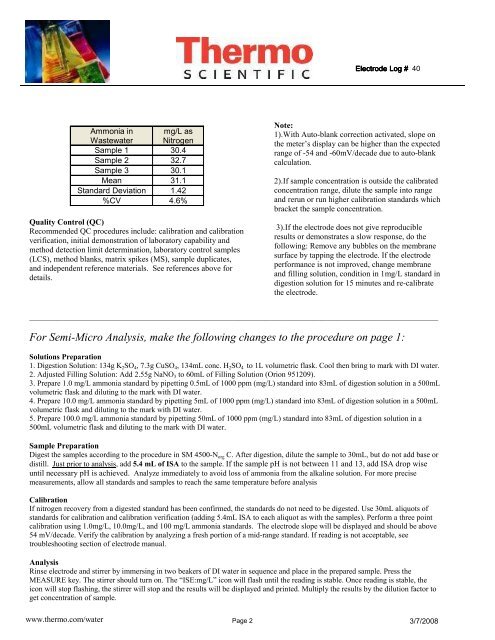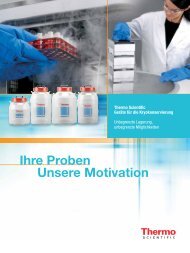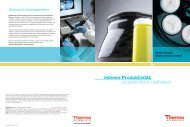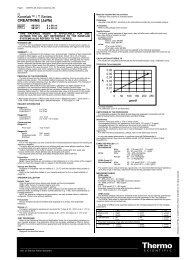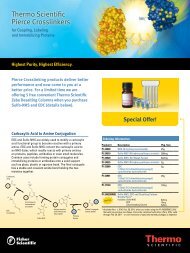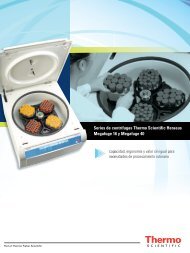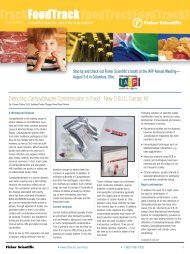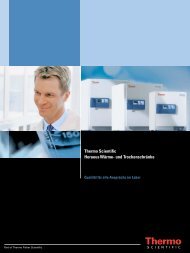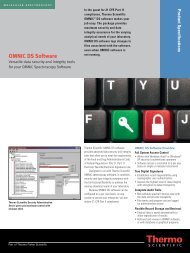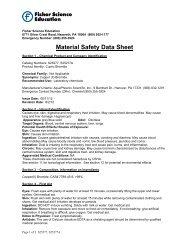Kjeldahl Nitrogen in Digested Sample
Kjeldahl Nitrogen in Digested Sample
Kjeldahl Nitrogen in Digested Sample
Create successful ePaper yourself
Turn your PDF publications into a flip-book with our unique Google optimized e-Paper software.
Ammonia <strong>in</strong> mg/L as<br />
Wastewater <strong>Nitrogen</strong><br />
<strong>Sample</strong> 1 30.4<br />
<strong>Sample</strong> 2 32.7<br />
<strong>Sample</strong> 3 30.1<br />
Mean 31.1<br />
Standard Deviation 1.42<br />
%CV 4.6%<br />
Quality Control (QC)<br />
Recommended QC procedures <strong>in</strong>clude: calibration and calibration<br />
verification, <strong>in</strong>itial demonstration of laboratory capability and<br />
method detection limit determ<strong>in</strong>ation, laboratory control samples<br />
(LCS), method blanks, matrix spikes (MS), sample duplicates,<br />
and <strong>in</strong>dependent reference materials. See references above for<br />
details.<br />
Electrode Electrode Electrode Log Log Log # # 40<br />
Note:<br />
1).With Auto-blank correction activated, slope on<br />
the meter’s display can be higher than the expected<br />
range of -54 and -60mV/decade due to auto-blank<br />
calculation.<br />
2).If sample concentration is outside the calibrated<br />
concentration range, dilute the sample <strong>in</strong>to range<br />
and rerun or run higher calibration standards which<br />
bracket the sample concentration.<br />
3).If the electrode does not give reproducible<br />
results or demonstrates a slow response, do the<br />
follow<strong>in</strong>g: Remove any bubbles on the membrane<br />
surface by tapp<strong>in</strong>g the electrode. If the electrode<br />
performance is not improved, change membrane<br />
and fill<strong>in</strong>g solution, condition <strong>in</strong> 1mg/L standard <strong>in</strong><br />
digestion solution for 15 m<strong>in</strong>utes and re-calibrate<br />
the electrode.<br />
_____________________________________________________________________________________________________<br />
For Semi-Micro Analysis, make the follow<strong>in</strong>g changes to the procedure on page 1:<br />
Solutions Preparation<br />
1. Digestion Solution: 134g K 2SO 4, 7.3g CuSO 4, 134mL conc. H 2SO 4 to 1L volumetric flask. Cool then br<strong>in</strong>g to mark with DI water.<br />
2. Adjusted Fill<strong>in</strong>g Solution: Add 2.55g NaNO 3 to 60mL of Fill<strong>in</strong>g Solution (Orion 951209).<br />
3. Prepare 1.0 mg/L ammonia standard by pipett<strong>in</strong>g 0.5mL of 1000 ppm (mg/L) standard <strong>in</strong>to 83mL of digestion solution <strong>in</strong> a 500mL<br />
volumetric flask and dilut<strong>in</strong>g to the mark with DI water.<br />
4. Prepare 10.0 mg/L ammonia standard by pipett<strong>in</strong>g 5mL of 1000 ppm (mg/L) standard <strong>in</strong>to 83mL of digestion solution <strong>in</strong> a 500mL<br />
volumetric flask and dilut<strong>in</strong>g to the mark with DI water.<br />
5. Prepare 100.0 mg/L ammonia standard by pipett<strong>in</strong>g 50mL of 1000 ppm (mg/L) standard <strong>in</strong>to 83mL of digestion solution <strong>in</strong> a<br />
500mL volumetric flask and dilut<strong>in</strong>g to the mark with DI water.<br />
<strong>Sample</strong> Preparation<br />
Digest the samples accord<strong>in</strong>g to the procedure <strong>in</strong> SM 4500-N org C. After digestion, dilute the sample to 30mL, but do not add base or<br />
distill. Just prior to analysis, add 5.4 mL of ISA to the sample. If the sample pH is not between 11 and 13, add ISA drop wise<br />
until necessary pH is achieved. Analyze immediately to avoid loss of ammonia from the alkal<strong>in</strong>e solution. For more precise<br />
measurements, allow all standards and samples to reach the same temperature before analysis<br />
Calibration<br />
If nitrogen recovery from a digested standard has been confirmed, the standards do not need to be digested. Use 30mL aliquots of<br />
standards for calibration and calibration verification (add<strong>in</strong>g 5.4mL ISA to each aliquot as with the samples). Perform a three po<strong>in</strong>t<br />
calibration us<strong>in</strong>g 1.0mg/L, 10.0mg/L, and 100 mg/L ammonia standards. The electrode slope will be displayed and should be above<br />
54 mV/decade. Verify the calibration by analyz<strong>in</strong>g a fresh portion of a mid-range standard. If read<strong>in</strong>g is not acceptable, see<br />
troubleshoot<strong>in</strong>g section of electrode manual.<br />
Analysis<br />
R<strong>in</strong>se electrode and stirrer by immers<strong>in</strong>g <strong>in</strong> two beakers of DI water <strong>in</strong> sequence and place <strong>in</strong> the prepared sample. Press the<br />
MEASURE key. The stirrer should turn on. The “ISE:mg/L” icon will flash until the read<strong>in</strong>g is stable. Once read<strong>in</strong>g is stable, the<br />
icon will stop flash<strong>in</strong>g, the stirrer will stop and the results will be displayed and pr<strong>in</strong>ted. Multiply the results by the dilution factor to<br />
get concentration of sample.<br />
www.thermo.com/water<br />
Page 2 3/7/2008


